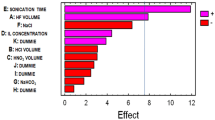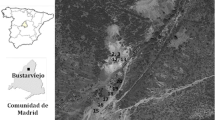Abstract
Ultrasound-assisted extraction is frequently used to prepare analytical samples and is considered an alternative to conventional extraction techniques. Extraction procedures are used in the fractionation analysis for the isolation of various element species. The recoveries of elements in the ultrasonic extracts were tested by comparing these results with those of conventional extraction procedures. Contents of Cu, Pb, and Zn in extracts obtained by both the conventional and the ultrasound-assisted extraction were determined by flame atomic absorption spectrometry. The optimal conditions for the ultrasound-assisted extraction (sonication power = 90%, depth of ultrasonic probe = 4 cm) were determined, and the extraction time was shortened to 6 min (using EDTA) and to 5 min using HNO3 extraction reagent.



Similar content being viewed by others
References
Broekaert JAC, Gücer S, Adams F (1990) Metal speciation in the environment. Springer, Heidelberg
Templeton DM, Ariese F, Cornelis R, Danielsson LG, Muntau H, Van Leeuwen HP, Łobiński R (2000) Guidelines for terms related to chemical speciation and fractionation of elements. Definitions, structural aspect, and methodological approaches. Pure Appl Chem 72:1456
Remeteiová D, Sminčáková E, Flórián K (2007) Study of chemical properties of gravitation dust sediments. Michrochim Acta 156:109–113
Ure AM, Davidson CM, Thomas RP (1995) Single and sequential extraction schemes for trace metal speciation in soil and sediment, Quality Assurance for Environmental Analysis, ed. Elsevier Science B. V., ch. 20:505–523
Makovníková, J (2000) Distribution of Cd, Pb, Cu, and Zn in Soil and its Evaluation Considering on Potentials and Barriers of Metal Transport to Plants P.35, Research Institute of soil science and soil conservation, Bratislava
Özkan MH, Gürkan R, Özkan A, Akçay M (2005) Determination of Manganese and Lead on roadside soil samples by FAAS with ultrasound assisted leaching. J Anal Chem 60(5):69–474
Peréz-C B, Lavilla I, Bendicho C (1998) Speeding up of three-stage sequential extraction method for metal speciation using focused ultrasound. Anal Chim Acta 60:35–41
Ashley K, Andreews RN, Cavazos L, Demange M (2001) Ultrasonic extraction as a sample preparation technique for elemental analysis by atomic spectrometry. J Anal at Spectrom 16:1147–1153
Väisänen A, Suontamo R, Silvonen J, Rintala J (2002) Ultrasound-assisted extraction in the determination of arsenic, cadmium, lead, and silver in contaminated soil samples by inductively coupled plasma atomic emission spectrometry. Anal Bioanal Chem 373:93–97
Hristozov D, Domini CE, Kmetov V, Stefanova V, Georgieva D, Canals A (2004) Direct ultrasound-assisted extraction of heavy metals from sewage sludge samples for ICP-OES analysis. Anal Chim Acta 516:187–196
Alexo PA, Júnior DS, Tomazelli AC, Rufini IA, Berndt H, Krug FJ (2004) Cadmium and lead determination in foods by beam injection flame furnace atomic absorption spectrometry after ultrasound-assisted sample preparation. Anal Chim Acta 512:329–337
Davidson CM, Delevoye G (2001) Effect of ultrasonic agitation on the release of copper, iron, manganese, and zinc from soil and sediment using the BCR three-stage sequential extraction. J Environ Monit 3:398–403
Ipolyi I, Brunori C, Cremisini C, Fodor P, Macaluso L, Morabito R (2002) Evaluation of performance of time-saving extraction devices in the BCR three-step sequential extraction procedure. J Environ Monit 4:12–19
Remeteiová D, Krakovská E, Tomko J, Sminčáková E, Vojteková V (2002) Extrakcia vzoriek prašných spadov EDTA (Extraction of gravitation dust sediment samples by EDTA). Sborník konference “Mikroelementy 2002”, Slapy:124–128
Tomko J, Krakovská E, Remeteiová D, Sminčáková E (2002) Stanovenie mobilizovateľného obsahu niektorých kovov v prašnom spade 2 M HNO3 (determination of the mobilizable content of some elements in the dust sediment by 2 M HNO3). Sborník konference “Mikroelementy 2002”, Slapy:129–133
Acknowledgements
This research was supported by projects VEGA 1/3149/06 and APVV 20-0094-04.
Author information
Authors and Affiliations
Corresponding author
Rights and permissions
About this article
Cite this article
Remeteiová, D., Ružičková, S. & Rusnák, R. Ultrasound-assisted extraction in the fractionation analysis of gravitation dust sediments. Microchim Acta 163, 257–261 (2008). https://doi.org/10.1007/s00604-008-0005-6
Received:
Accepted:
Published:
Issue Date:
DOI: https://doi.org/10.1007/s00604-008-0005-6




